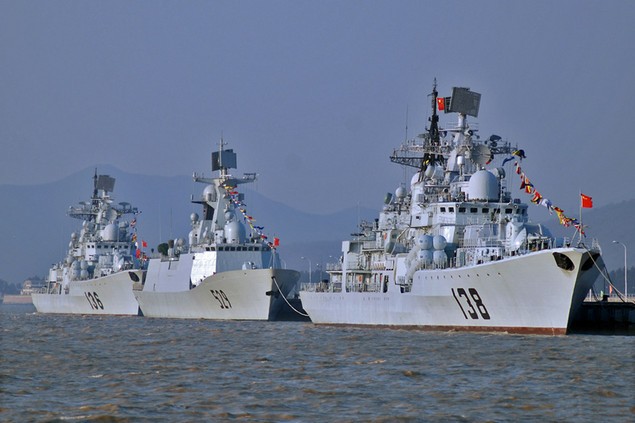Iranian Ship Linked to Houthi Attacks Heads Home Amid Tensions
(Bloomberg) — An Iranian ship that’s been linked to Houthi attacks in the Red Sea is returning home, removing a prominent asset in the area as the Islamic Republic braces...


By Bloomberg News
(Bloomberg) — China set out its ambitions for a bigger naval presence far from its coasts, amid wariness among its neighbors over whether the country’s fleet will be used to back up its territorial claims.
The People’s Liberation Army will add “open seas protection” to “offshore waters defense” on a list of core naval missions, according to the country’s 2015 defense white paper. China must expand on its “active defense strategy” to meet the demands of a new historical era.
[contextly_sidebar id=”PfjbiXpZrFeSmD8cLCjmxWkDE2gAzwWX”]“The maritime battlefield has been broadened, and China’s navy needs to react to protect its rights globally,” Wang Jin, a PLA senior colonel, said at a briefing in Beijing on Tuesday.
China’s increased naval might, as well as its assertion to territory in the contested South China Sea and East China Sea, has helped spur the region’s largest military buildup in decades. It has shown a greater willingness to project power far from its coasts, evacuating workers from Yemen and joining Russia for naval exercises in the Mediterranean.
The release of the white paper came as the official Xinhua news agency reported that China has started construction of two large lighthouses on reefs in the South China Sea. The lighthouses will provide navigation services for ships from different countries, Xinhua said, citing the transport ministry.
“This posture reflects China’s rising reliance on the oceans for its economic prosperity,” said Zhang Baohui, director of the Center for Asian Pacific Studies at Lingnan University in Hong Kong. “However, it has also intensified the security dilemma with other countries, such as the U.S., Japan and India, who distrust China’s maritime agenda.”
Chinese Dream
The paper — entitled “China’s Military Strategy” — sets out how the armed forces will contribute to President Xi Jinping’s plan to rejuvenate the nation and what he calls the “Chinese dream.” The most recent white paper, published in 2013, focused on the organization of the various arms of China’s military.
In the U.S., a Pentagon spokesman said the paper had the virtue of candor, adding that the Chinese government had informed American defense officials about it almost a year ago.
“We’ve repeatedly called on the Chinese for transparency and, frankly, this is transparency,” the spokesman, Army Colonel Steve Warren, told reporters on Tuesday. “This is a step in the right direction.”
Pentagon’s Warning
The Pentagon’s annual report on China’s military, released earlier this month, warned that rapid military modernization “has the potential to reduce core U.S. military technological advantages.” Absent from China’s almost 9,000-word paper were details about how its military budget was divided among the various services.
The document underscored “the principles of defense, self- defense and post-emptive strike,” saying: “We will not attack unless we are attacked, but we will surely counter attack if attacked.” The armed forces will intensify participation in international peacekeeping and humanitarian assistance, the paper said.
“The scope, distance and the ability to project power have all grown,” said Ni Lexiong, director of the Sea Power and Defense Policy Research Institute at the Shanghai University of Political Science and Law. “The paper highlights the ‘active’ element in China’s existing military strategy, and and it’s best manifested in its navy.”
Airspace Tested
The document noted new threats of “hegemonism, power politics and neo-interventionism” in a region where the U.S. and others have sought to test China’s control of airspace and waters around islands and reefs. The U.S. last week flew a P8-A surveillance aircraft near the Spratly islands in the South China Sea, where China is building islands. The flight elicited warnings from the Chinese navy to leave.
“Some external countries are also busy meddling in South China Sea affairs; a tiny few maintain a constant close-in air and sea surveillance and reconnaissance against China,” the white paper said. “It is thus a long-standing task for China to safeguard its maritime rights and interests.”
While the risk of a global war is unlikely the paper noted the threat of local conflicts, stemming from things like ethnic and religious strife. “International competition for the redistribution of power, rights and interests is tending to intensify.”
The military plans to hasten development of four “critical security domains” – the ocean, outer space, cyberspace and its nuclear force, it said.
“Long range, precise, smart, stealthy, and unmanned weapons and equipment are becoming increasingly sophisticated,” the paper said. “The form of war is accelerating its evolution to informatioinization.”
–With assistance from David Lerman in Washington.
©2015 Bloomberg News
Join the gCaptain Club for curated content, insider opinions, and vibrant community discussions.


Join the 105,954 members that receive our newsletter.
Have a news tip? Let us know.
Access exclusive insights, engage in vibrant discussions, and gain perspectives from our CEO.
Sign Up




Maritime and offshore news trusted by our 105,954 members delivered daily straight to your inbox.



Essential news coupled with the finest maritime content sourced from across the globe.
Sign Up